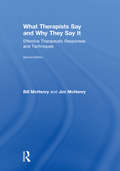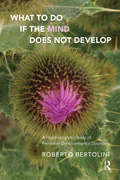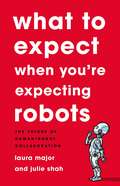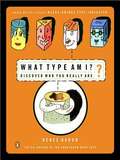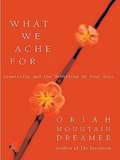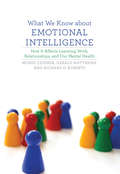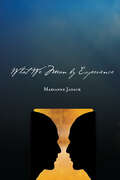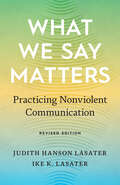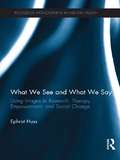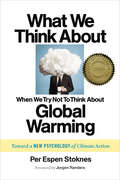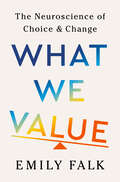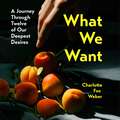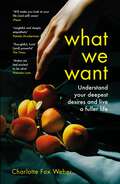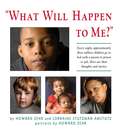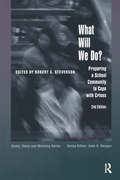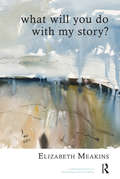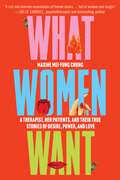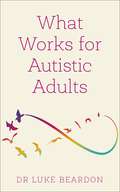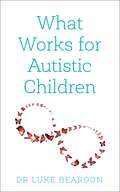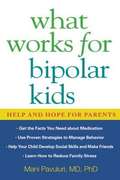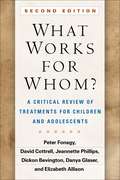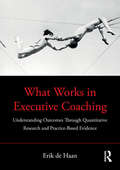- Table View
- List View
What Therapists Say and Why They Say It: Effective Therapeutic Responses and Techniques
by Bill Mchenry Jim MchenryWhat Therapists Say and Why They Say It, 2nd ed, is one of the most practical and flexible textbooks available to counseling students. The new edition includes more than one hundred techniques and more than a thousand specific therapeutic responses that elucidate, in the most concrete possible way, not just why but how to practice good therapy. Transcripts show students how to integrate and develop content during sessions, and practice exercises help learners develop, discuss, combine, and customize various approaches to working with clients. The second edition is designed specifically for use as a main textbook, and it includes more detailed explanations of both different counseling modalities and the interaction between techniques and the counseling process--for example, the use of Socratic and circular questions within the art therapy process. What Therapists Say and Why They Say It, 2nd ed, is also designed to help students make clear connections between the skills they learn in prepracticum and practicum with other courses in the curriculum--especially the 8 core CACREP areas.
What To Do If the Mind Does Not Develop: A Psychoanalytic Study of Pervasive Developmental Disorders
by Roberto BertoliniThe result of three decades of psychoanalytic work with children and adolescents, this book takes a fresh and empathic look on the pervasive developmental disorders in childhood and adolescence, describing their many manifestations through the presentation of particularly representative clinical cases, in pages of high scientific rigour but also of simple and poetic language. What To Do if the Mind Does Not Develop speaks both to the specialist and researcher and to the reader who is simply interested in the topic, thanks also to a glossary of the more difficult technical terms. The text offers valuable psychoanalytic observations on the cognitive and emotional difficulties of these patients that may help physicians, teachers, and parents to develop a better and deeper understanding of their true psychology.
What To Expect When You're Expecting Robots: The Future of Human-Robot Collaboration
by Laura Major Julie ShahThe next generation of robots will be truly social, but can we make sure that they play well in the sandbox?Most robots are just tools. They do limited sets of tasks subject to constant human control. But a new type of robot is coming. These machines will operate on their own in busy, unpredictable public spaces. They'll ferry deliveries, manage emergency rooms, even grocery shop. Such systems could be truly collaborative, accomplishing tasks we don't do well without our having to stop and direct them. This makes them social entities, so, as robot designers Laura Major and Julie Shah argue, whether they make our lives better or worse is a matter of whether they know how to behave.What to Expect When You're Expecting Robots offers a vision for how robots can survive in the real world and how they will change our relationship to technology. From teaching them manners, to robot-proofing public spaces, to planning for their mistakes, this book answers every question you didn't know you needed to ask about the robots on the way.
What Type Am I?: Discover Who You Really Are
by Renee BaronThe Myers-Briggs Type Indicator (MBTI) is the most widely used psychological indicator in the world. Millions of people take the test annually. Now a family therapist explains this fascinating system of ideas to the public in a way that is entertaining and easy to absorb. Based on the work of Carl Jung, the MBTI is a system that discusses people's individual preferences on four basic scales: how they relate to the world, take in information, make decisions, and manage their lives. Renee Baron takes on the complexity of the sixteen personality types and makes them accessible so the general reader can comprehend them, find their own type, and use the knowledge to enrich their own lives. She presents information about individual strengths and weaknesses along with suggestions for personal growth and awareness. Insightful, helpful, and encouraging, What Type Am I? is the only user-friendly guide to the MBTI'and an eminently useful step in helping individuals appreciate, and apply their strength, to work, love, and life. Baron has co-authored two bestselling books: Are You My Type, Am I Yours and The Eneagram Made Easy
What We Ache For: Creativity and the Unfolding of Your Soul
by Oriah Mountain DreamerInspirational guide to awakening personal creativity in any art form. Dreamer uses practical examples to convey the link between creativity, spirituality, and sexuality while showing how all 3 can enrich one's life.
What We Know about Emotional Intelligence: How It Affects Learning, Work, Relationships, and Our Mental Health
by Gerald Matthews Moshe Zeidner Richard D. RobertsSorting out the scientific facts from the unsupported hype about emotional intelligence.Emotional intelligence (or EI)—the ability to perceive, regulate, and communicate emotions, to understand emotions in ourselves and others—has been the subject of best-selling books, magazine cover stories, and countless media mentions. It has been touted as a solution for problems ranging from relationship issues to the inadequacies of local schools. But the media hype has far outpaced the scientific research on emotional intelligence. In What We Know about Emotional Intelligence, three experts who are actively involved in research into EI offer a state-of-the-art account of EI in theory and practice. They tell us what we know about EI based not on anecdote or wishful thinking but on science.What We Know about Emotional Intelligence looks at current knowledge about EI with the goal of translating it into practical recommendations in work, school, social, and psychological contexts.
What We Mean by Experience
by Marianne JanackSocial scientists and scholars in the humanities all rely on first-person descriptions of experience to understand how subjects construct their worlds. The problem they always face is how to integrate first-person accounts with an impersonal stance. Over the course of the twentieth century, this problem was compounded as the concept of experience itself came under scrutiny. First hailed as a wellspring of knowledge and the weapon that would vanquish metaphysics and Cartesianism by pragmatists like Dewey and James, by the century's end experience had become a mere vestige of both, a holdover from seventeenth-century empiricist metaphysics. This devaluation of experience has left us bereft, unable to account for first-person perspectives and for any kind of agency or intentionality. This book takes on the critique of empiricism and the skepticism with regard to experience that has issued from two seemingly disparate intellectual strains of thought: anti-foundationalist and holistic philosophy of science and epistemology (Kuhn and Rorty, in particular) and feminist critiques of identity politics. Both strains end up marginalizing experience as a viable corrective for theory, and both share notions of human beings and cognition that cause the problem of the relation between experience and our theories to present itself in a particular way. Indeed, they render experience an intractable problem by opening up a gap between a naturalistic understanding of human beings and an understanding of humans as cultural entities, as non-natural makers of meaning. Marianne Janack aims to close this gap, to allow us to be naturalistic and hermeneutic at once. Drawing on cognitive neuroscience, the pragmatist tradition, and ecological psychology, her book rescues experience as natural contact with the world.
What We Say Matters: Practicing Nonviolent Communication
by Judith Hanson Lasater Ike K. LasaterLearn how to communicate with compassion and choose language that reflects your personal values and aims with this essential guide to Nonviolent Communication.Judith Hanson Lasater and Ike Lasater, long-term students of yoga and Buddhism, had studied the concepts of satya (truth) and the Buddhist principle of right speech for years but it was not until they began practicing Marshall Rosenberg&’s techniques of Nonviolent Communication (NVC) that the concept of speech as a spiritual practice became real for them. In What We Say Matters, the authors describe their personal journey through NVC, and detail how speech becomes a spiritual practice when you give and receive with compassion all the time--at home, at work, and in the world. They introduce the basics of NVC with clear explanations, personal examples, exercises, and resources. Some of the skills you&‘ll learn include: Extending empathy to yourself and others Distinguishing between feelings and needs Making requests rather than demands Creating mutually satisfying outcomes And many moreThis new edition includes updated resources and a preface by Judith Hanson Lasate.
What We See and What We Say: Using Images in Research, Therapy, Empowerment, and Social Change (Routledge Monographs in Mental Health)
by Ephrat HussImage-based research methods, such as arts-based research, can fill the absence of the voice of impoverished, under-privileged populations. In What We See and What We Say, Ephrat Huss argues that images are deep and universally psycho-neurological constructs through which people process their experiences. The theoretical model demonstrated in this book demonstrates that images can be used to enable three different levels of communication: with self, with others similar to oneself, and with others who differ in terms of culture and power. Dr. Huss centers her argument on a case study of impoverished Bedouin women’s groups in Israel who used art as self-expression, and includes many additional examples such as unemployed women and teenage girls in slums, women who have underwent sexual abuse, and the experiences of illegal immigrants. Ultimately, the author points to how the inherent structural characteristics of images help to intensify the voices of marginalized groups in research, therapy, empowerment, and social action.
What We Think About When We Try Not To Think About Global Warming: Toward a New Psychology of Climate Action
by Per Espen StoknesWhy does knowing more mean believing—and doing—less? A prescription for changeThe more facts that pile up about global warming, the greater the resistance to them grows, making it harder to enact measures to reduce greenhouse gas emissions and prepare communities for the inevitable change ahead.It is a catch-22 that starts, says psychologist and economist Per Espen Stoknes, from an inadequate understanding of the way most humans think, act, and live in the world around them. With dozens of examples—from the private sector to government agencies—Stoknes shows how to retell the story of climate change and, at the same time, create positive, meaningful actions that can be supported even by deniers.In What We Think About When We Try Not To Think About Global Warming, Stoknes not only masterfully identifies the five main psychological barriers to climate action, but addresses them with five strategies for how to talk about global warming in a way that creates action and solutions, not further inaction and despair.These strategies work with, rather than against, human nature. They are social, positive, and simple—making climate-friendly behaviors easy and convenient. They are also story-based, to help add meaning and create community, and include the use of signals, or indicators, to gauge feedback and be constantly responsive.Whether you are working on the front lines of the climate issue, immersed in the science, trying to make policy or educate the public, or just an average person trying to make sense of the cognitive dissonance or grapple with frustration over this looming issue, What We Think About When We Try Not To Think About Global Warming moves beyond the psychological barriers that block progress and opens new doorways to social and personal transformation.
What We Value: The Neuroscience of Choice and Change
by Emily FalkA neuroscientist reveals the hidden calculations that shape our daily decisions—and how to make more fulfilling, impactful choices in our work, relationships, and lives. With so many competing priorities pulling us in different directions every day—family, friends, work, our health—it can feel difficult to make decisions that are aligned with what we care about most. Especially in the moment, we often default to the immediate demand, the path of least resistance, the worn old habit we wanted to change. In What We Value, pioneering scholar Emily Falk reveals how we can transform our relationship with the daily decisions that define our lives—opening pathways to make more purposeful, fulfilling choices; more successfully change our behavior; and influence others to see differently—by thinking like neuroscientists. Drawing on her own award-winning research, Falk introduces readers to a new paradigm for understanding why we, and those around us, do what we do. This is the value calculation: the often-subconscious mechanism by which the brain computes our everyday choices. By learning how it works, Falk shows, we can learn to work more strategically with it—whether we want to embrace new activities and behaviors, connect more meaningfully with others, or become more effective leaders in our organizations and communities. With captivating stories of star comedians, journalists, sports legends, and more, Falk demonstrates how we can change what we think just by changing what we think about; get less defensive by connecting with our core values; and seed innovation by seeking out different perspectives. Whether deciding on something as small as what to eat for lunch or as big as what career to pursue, we can have more agency and flexibility than we might think. What We Value is a groundbreaking guide to finding new possibilities in our choices—and the lives we ultimately make with them.
What We Want: A Journey Through Twelve of Our Deepest Desires
by Charlotte Fox WeberChloe is beautiful and fiercely bright, but her thirst for booze and attention is insatiable.Sara resents being tied down to anything, but part of her craves stability.Elliot is secretly grieving the death of his famous lover and feels like he's invisible.The lives and problems of psychotherapist Charlotte Fox Weber's clients vary, but all are united by a common question: what do I really want?In What We Want, Charlotte Fox Weber takes us on a journey through twelve universal wants and desires, bringing us behind the closed doors of her practice. It is at once a fly-on-the-wall look at what binds us all, an expression of the profound importance of understanding and articulating our desires, and a practical toolkit for living well.(P) 2022 Headline Publishing Group Ltd
What We Want: A Journey Through Twelve of Our Deepest Desires
by Charlotte Fox Weber'Thoughtful, lucid and blessedly free of therapese . . . Weber's book is a powerful snapshot into the little bombs going off in the lives and homes of those around us' SUNDAY TIMES'Finely crafted, profound and always generous . . . Made me feel excited to be alive' NATASHA LUNNOur secret wants and desires are often hidden in a box. But what happens when you lift the lid? Chloe is beautiful and fiercely bright, but her thirst for alcohol and attention is insatiable.Sara resents being tied down to anything, but part of her craves stability.Elliot is secretly grieving the death of his famous lover and feels like he's invisible.The lives and problems of psychotherapist Charlotte Fox Weber's clients vary, but all are united by a common question: what do I really want?In What We Want, Charlotte Fox Weber takes us on a journey through twelve universal wants and desires - love, power, sex, attention, and more - bringing us behind the closed doors of her practice. As she gently guides her clients towards a deeper understanding of themselves, she invites them - and us - to find a fuller way of living.What We Want is at once a fly-on-the-wall look at what binds us all, an expression of the profound importance of understanding and articulating our desires, and a practical toolkit for living well.More Love for What We Want:'Insightful and deeply empathetic . . . Offers hope that we can actually get better' PAMELA DRUCKERMAN'Will surely convince even the most sceptical critic that effective counselling can truly transform lives' CHRISTIE TATE
What Will Happen to Me: Every Night, Approximately Three Million Children Go To Bed With A Parent In Pri
by Howard ZehrWhat is life like for a child who has a parent in prison? This book brings together photographic portraits of 30 children whose parents are incarcerated, along with their thoughts and reflections, in their own words. As Taylor says, "I want other kids to know that, even though your parents are locked up, they're not bad people. "And I want them to know that we'll get through it. As long as we have someone there to help us, we can get through it. It makes you stronger." The material in "What Will Happen to Me?" has been gathered and written by two nationally-recognized experts. Howard Zehr is known around the world as the "grandfather of restorative justice." He lectures and consults internationally on that topic and related issues. He is currently a member of the Victims Advisory Group of the U.S. Sentencing Commission. Lorraine Stutzman Amstutz travels the U.S. doing mediation work in severe crime cases. She provides consulting and training for agencies and communities seeking to implement programs of restorative justice. This book of portraits and text includes: Reflections of several grandparents who are unexpectedly parenting children whose parents are incarcerated. "Ten Questions Often Asked by Children." "Dealing with Emotions"-including grief and loss, shame and stigma, anger and isolation. Resources for "Staying in Touch," "Finding Moments of Celebration," "Adjusting to a Parent's Return," "Self-Care for Family Caregivers," and "Suggestions for Third-Party Caregivers." "The Children's Bill of Rights," along with thoughtful consideration about how to apply restorative justice and respect for relationships in these difficult situations.
What Will We Do?: Preparing a School Community to Cope with Crises (Death, Value and Meaning Series)
by Robert G. StevensonThe second edition of ""What Will We Do? Preparing A School Community to Cope With Crises"" is a guidebook for educators and parents who wish to understand the importance of both pre- and post-intervention programs in our schools to assist all parties in coping with crises that arise. The book examines the scope and effects (including the potential benefits and possible risks) of programs that target such issues as loss, illness, death, grief, war, and violence. It presents specific steps that can be taken to help prepare a school community to cope with possible future crises. Today's news has shown us with dramatic effect that a crisis can occur at any time, often without warning. Educators and parents must work together if they wish to help young people, and each other, when such a crisis occurs. What Will We Do? is a major step in that direction.
What Will You Do With My Story?: What Will You Do With My Story? (The\united Kingdom Council For Psychotherapy Ser.)
by Elizabeth MeakinsThe author uses her popular columns from The Independent to explore the therapeutic process. Successful analysis, she argues, is less about following pre-formulated theory and more about being led by the experience of what is actually happening.
What Women Want: A Therapist, Her Patients, and Their True Stories of Desire, Power, and Love
by Maxine Mei-Fung ChungA profound and intimate exploration of female desire and identity, as studied through the lives of seven female therapy patients by award-winning psychotherapist Maxine Mei-Fung Chung. Sigmund Freud once said: &‘The great question that has never been answered, and which I have not yet been able to answer, despite my thirty years of research into the feminine soul, is &“What does a woman want?&”' Through the relatable and moving stories of seven very different women, Maxine Mei-Fung Chung refutes this inscrutability and sheds light on our most fundamental needs and desires. From a young bride-to-be struggling to accept her sexuality, to a mother grappling with questions of identity and belonging, and a woman learning to heal after years of trauma, What Women Want is an electrifying and deeply intimate exploration into the inner lives of women. Based on hours of conversations between Maxine and her patients, this book lays bare our fears, hopes, secrets and capacity for healing. With great empathy and precision, What Women Want presents a fearless look into the depths of who we are, so that we can better understand each other and ourselves. To desire is an action. This extraordinary book liberates and empowers us to claim what we truly want.
What Works for Autistic Adults
by Luke Beardon'This book has the power to change lives' Chris PackhamImagine a world where an autistic person is included, engaged and cherished for how they are; a world which changes for autistic people, rather than changing the person.What Works for Autistic Adults brings the conversation about inclusivity into the forefront and turns it on its head. Instead of modifying the autistic individual and making exceptions or special circumstances, Luke shows how the world can, should and must change to accommodate your needs or those of the autistic person you love, live or work with.He identifies the aspects that impact on life most - partners, friends, work or college, and environment - and outlines the steps that can and should be taken by everyone involved to create an autism-friendly landscape and improve outcomes all round. Covering every setting, from social situations to office or other professional environments, and in all circumstances, Luke's book shows how no-one should have to struggle to exist within the parameters of a world they don't understand. What Works for Autistic Adults will give you the dialogue, tools and starting points to involve every loved one, family member or colleague as advocates for a world where you, or any other autistic adult, can truly flourish.
What Works for Autistic Adults
by Luke Beardon'This book has the power to change lives' Chris PackhamImagine a world where an autistic person is included, engaged and cherished for how they are; a world which changes for autistic people, rather than changing the person.What Works for Autistic Adults brings the conversation about inclusivity into the forefront and turns it on its head. Instead of modifying the autistic individual and making exceptions or special circumstances, Luke shows how the world can, should and must change to accommodate your needs or those of the autistic person you love, live or work with.He identifies the aspects that impact on life most - partners, friends, work or college, and environment - and outlines the steps that can and should be taken by everyone involved to create an autism-friendly landscape and improve outcomes all round. Covering every setting, from social situations to office or other professional environments, and in all circumstances, Luke's book shows how no-one should have to struggle to exist within the parameters of a world they don't understand. What Works for Autistic Adults will give you the dialogue, tools and starting points to involve every loved one, family member or colleague as advocates for a world where you, or any other autistic adult, can truly flourish.
What Works for Autistic Children
by Luke BeardonImagine a world where your autistic child is included, engaged and cherished for how they are; a world which changes for autistic children, rather than changing the child.What Works for Autistic Children brings the conversation about inclusivity into the forefront and turns it on its head. Instead of modifying the autistic child and making exceptions or special circumstances, Luke shows you, the parent, how the world can, should and must change to accommodate your child. He identifies the aspects that impact on your child's life most - the family, their school, their friends, their environment - and outlines the steps that can and should be taken by everyone involved to improve their outcome and create an autism-friendly landscape.From early communication, through pre-school, primary school, secondary school - on holidays, school trips and with friends - your child should not have to struggle to exist within the parameters of a world they don't understand. What Works for Autistic Children will give you the dialogue, tools and starting points to involve every professional and family member as advocates for a world where your child flourishes.
What Works for Autistic Children
by Luke BeardonImagine a world where your autistic child is included, engaged and cherished for how they are; a world which changes for autistic children, rather than changing the child.What Works for Autistic Children brings the conversation about inclusivity into the forefront and turns it on its head. Instead of modifying the autistic child and making exceptions or special circumstances, Luke shows you, the parent, how the world can, should and must change to accommodate your child. He identifies the aspects that impact on your child's life most - the family, their school, their friends, their environment - and outlines the steps that can and should be taken by everyone involved to improve their outcome and create an autism-friendly landscape.From early communication, through pre-school, primary school, secondary school - on holidays, school trips and with friends - your child should not have to struggle to exist within the parameters of a world they don't understand. What Works for Autistic Children will give you the dialogue, tools and starting points to involve every professional and family member as advocates for a world where your child flourishes.
What Works for Bipolar Kids
by Mani PavuluriIt may be hard to believe your child will ever get better, but kids with bipolar disorder can and do lead healthy, stable lives. In this compassionate and optimistic book, expert clinician and renowned researcher Mani Pavuluri delivers information, advice, and proven strategies that empower you to deal with the challenges of bipolar disorder and help your child get well. Drawing on 20 years of experience with bipolar kids and their families, she provides solidly researched strategies for reducing or eliminating problems with mania, aggression, sleep disturbances, depression, and other issues. You'll discover practical ways to handle crises at home and in school, work with professionals to find an effective combination of medicine and psychotherapy, and cultivate a supportive community of friends and peers for your child. Dr. Pavuluri also helps you deal with the stress that comes with parenting, so you can maintain your poise, focus on the positive, and be a powerful advocate for your child.
What Works for Whom?, Second Edition
by David Cottrell Peter Fonagy Danya Glaser Jeannette Phillips Dickon Bevington Elizabeth AllisonThe standard reference in the field, this acclaimed work synthesizes findings from hundreds of carefully selected studies of mental health treatments for children and adolescents. Chapters on frequently encountered clinical problems systematically review the available data, identify gaps in what is known, and spell out recommendations for evidence-based practice. The authors draw on extensive clinical experience as well as research expertise. Showcasing the most effective psychosocial and pharmacological interventions for young patients, they also address challenges in translating research into real-world clinical practice. New to This Edition *Incorporates over a decade of research advances and evolving models of evidence-based care. *New chapter topic: child maltreatment. *Separate chapters on self-injurious behavior, eating disorders, and substance use disorders (previously covered in a single chapter on self-harming disorders). *Expanded chapters on depression, anxiety, and conduct disorder. *Includes reviews of the burgeoning range of manualized psychosocial "treatment packages" for children.
What Works for Whom?, Second Edition
by David Cottrell Peter Fonagy Danya Glaser Jeannette Phillips Dickon Bevington Elizabeth AllisonThe standard reference in the field, this acclaimed work synthesizes findings from hundreds of carefully selected studies of mental health treatments for children and adolescents. Chapters on frequently encountered clinical problems systematically review the available data, identify gaps in what is known, and spell out recommendations for evidence-based practice. The authors draw on extensive clinical experience as well as research expertise. Showcasing the most effective psychosocial and pharmacological interventions for young patients, they also address challenges in translating research into real-world clinical practice. New to This Edition *Incorporates over a decade of research advances and evolving models of evidence-based care. *New chapter topic: child maltreatment. *Separate chapters on self-injurious behavior, eating disorders, and substance use disorders (previously covered in a single chapter on self-harming disorders). *Expanded chapters on depression, anxiety, and conduct disorder. *Includes reviews of the burgeoning range of manualized psychosocial "treatment packages" for children.
What Works in Executive Coaching: Understanding Outcomes Through Quantitative Research and Practice-Based Evidence
by Erik de HaanThis book reviews the full coaching outcome research literature to examine the arguments and evidence behind the use of executive coaching. Erik de Haan presents the definitive guide to what works in coaching and what changes coaching brings about, both for individual coaches and for organisations and commissioners. Accessibly written and based on contemporary quantitative research into coaching effectiveness, this book considers whether we know that coaching works, and, if so, whom it works for, and what it offers to those involved. What Works in Executive Coaching considers the entire body of academic literature on quantitative research in executive and workplace coaching, assessing the significant results and explaining how to apply them. Each chapter contains direct applications to coaching practice and clearly evaluates the evidence, defining what really works in executive coaching. Alongside its companion volume Critical Moments in Executive Coaching, this book is an essential guide to evidence-based effectiveness in coaching. It will be a key text for all coaching practitioners, including those in training.
